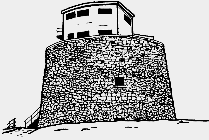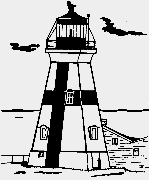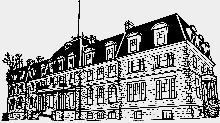 I start by drawing the building or site which I want to etch as a pen and ink drawing - each drawing will take between 3 and 6 hours to finish - depending upon the detail included in the drawing, and the complexity of the image.
I start by drawing the building or site which I want to etch as a pen and ink drawing - each drawing will take between 3 and 6 hours to finish - depending upon the detail included in the drawing, and the complexity of the image.After the drawing is complete, I scan it into a computer, re-touch any part which needs it, and the image is ready for use.
 The next step is printing out the transparencies from which each stencil will be made. The image is re-sized depending upon what item it is to be etched onto, the text is placed around it, and I laser print this layout onto clear plastic transparency film.
The next step is printing out the transparencies from which each stencil will be made. The image is re-sized depending upon what item it is to be etched onto, the text is placed around it, and I laser print this layout onto clear plastic transparency film.
Using a darkroom, I take a piece of the Photoresist, and place it on top of the transparency. It is now placed onto a UV light for 2 minutes, during which time the areas that are not protected by the black laser printing are developed. The exposed film is washed out with warm water and a sponge to remove all the areas of the film that haven't been developed, it's blotted dry, and then blown dry - if they aren't dried immediately, the small parts of film will move and the stencil will be un-usable.
 The glass item is marked with a felt pen so that each stencil will be placed in the same position (and straight...) and special glue is applied to the area. When this is dry, the stencil is placed on the glass, and pushed down.
The glass item is marked with a felt pen so that each stencil will be placed in the same position (and straight...) and special glue is applied to the area. When this is dry, the stencil is placed on the glass, and pushed down.
The carrier plastic on the stencil is removed (this keeps everything in place so that all the little pieces of stenciling get in the right spot). Then the stencil must be pushed down again to make sure there is no air under it (if there is air under parts of the stencil, it will be blown off when the piece is etched). Masking tape is then placed around the stencil to protect the rest of the glass not being etched.
 To do the actual etching, the piece is placed into a blasting booth, and a sand-blasting gun is used to remove the surface of the glass where the stenciling isn't protecting it. Care must also be taken not to hold the blasting gun on the glass too long, or the entire stencil will be blasted away. The sand used is a very fine grit, which gives the etch a delicate finish.
To do the actual etching, the piece is placed into a blasting booth, and a sand-blasting gun is used to remove the surface of the glass where the stenciling isn't protecting it. Care must also be taken not to hold the blasting gun on the glass too long, or the entire stencil will be blasted away. The sand used is a very fine grit, which gives the etch a delicate finish.
 The glass is now etched, but the stencil, masking tape, sand and dust all have to be removed. The glass is soaked in warm water for 10 minutes to loosen the glue, and everything is washed off the glass - everything that is except the etching - which is 100% permanent. Because the surface of the glass has been removed with the etching process, there is nothing to come off no matter how many times the piece is washed, wiped or used.
The glass is now etched, but the stencil, masking tape, sand and dust all have to be removed. The glass is soaked in warm water for 10 minutes to loosen the glue, and everything is washed off the glass - everything that is except the etching - which is 100% permanent. Because the surface of the glass has been removed with the etching process, there is nothing to come off no matter how many times the piece is washed, wiped or used.
![]()